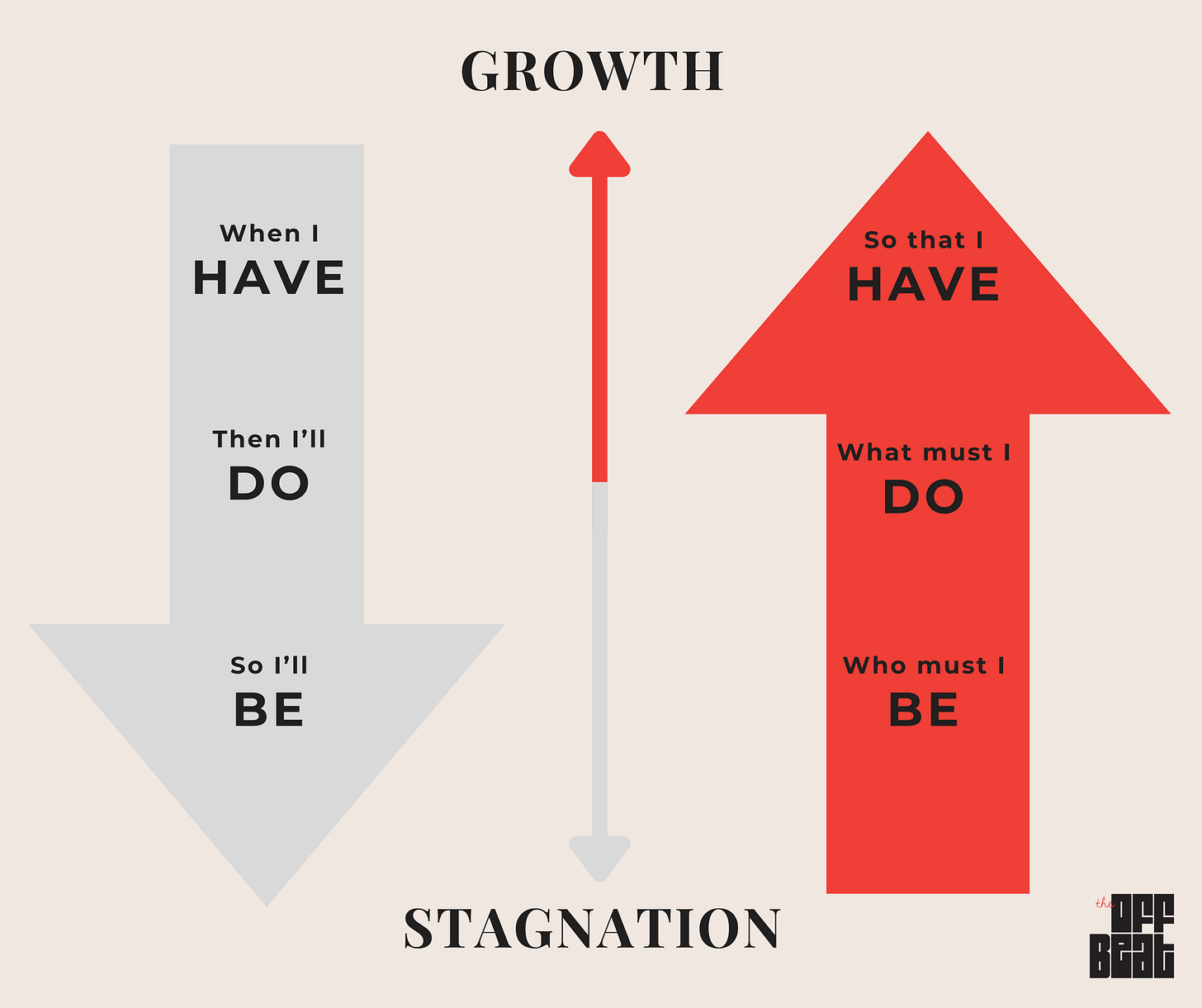The OffBeat #45: Music vs. Noise — How to Actually Complete Your Goals This Year
Including an editable goal-tracking template
Whether you’re a New Year’s resolution person, a New Year’s intentions person, a bucket list person, a “12 week year” person, or have some other bespoke annual goal-setting approach at work or at home (including just having a couple of loose aspirations for the year floating around your brain), it’s around this time that motivation starts to corrode.
Honestly, is it just me or has the rate of willpower depletion accelerated since COVID? Or maybe it dates back farther, to the 24/7 over-stimulation of social media. Or maybe it’s an inevitability of being a caregiver, for little ones, elderly ones, or unwell ones; or even just of having a full-time corporate job (burnout, anyone?).
Regardless, even the most thoughtful plans and detailed roadmaps butt up against the pure lack of motivation that is the destiny of an adult human in the 2020s. But too bad for us in the corporate world: there’s no escaping the need to create, and track, performance targets.
Considering goals through a mental model of music vs. noise has been helpful for me. A few organizing principles, and actionable tips for each:
Think in terms of systems (music), rather than goals (noise)
Thinking of goals as one-off milestones to achieve is a no-win game; either you fail to hit the goal and have to grapple with the psychological upheaval of non-accomplishment, or you complete the goal and, in so doing, lose the sense of purpose that drove you there, so need to create a new goal and start afresh.
Instead, consider the system you need to create in order to foster progress toward your ultimate aims. As Oliver Burkeman puts it:
“[F]ocusing on a system means focusing on what you can control (your actions) rather than what you can’t (the endlessly unpredictable external world). Keep working your system and you’ll maximise the chances that success will find you. Live in pursuit of goals and you’ll feel like a failure even when you’re succeeding.”
Put differently, individual goals are like noise; they’re disorganized reverberations of sound. Systems are like music; they’re structured arrangements of rhythm and pitch.
Examples of goals transformed into systems:
And some popular frameworks that help implement systems:
No Zero Days — or as Jerry Seinfeld put it, “Don’t break the chain!”
#24in24 — gamify it
National Novel Writing Month — tap into community accountability
Attune to the “Be ➡️ Do ➡️ Have” paradigm
Mike Robbins sums this up well:
“Most of us think we need to have certain things (more money, love, time, experience, etc.), so that we can finally do what we truly want to do (go for a promotion, pursue our passion, start a business, go on vacation, create a relationship, buy a home, etc.), in order to be what we truly want to be (peaceful, successful, fulfilled, inspired, generous, in love, etc.). In actuality, it works the other way around.
When we focus on being what we want (joyful, confident, abundant, accomplished, and more), we can start doing things from this powerful state of being—and soon we discover that what we’re doing winds up bringing us the things we’ve always wanted to have.”
Thinking about goal completion from the end-state perspective (the finished piece of music) as opposed to the baseline (a cacophony of individual notes) situates you in a mindset that’s much more helpful and whole. If you embody the state of being you anticipate coming from the achievement of a goal, the actions you should take arise naturally and frictionlessly. After all, as Robbins points out, we’re human beings, not human doings.

Some suggestions for shifting into the “be—do—have” mind frame:
Save the image above on your laptop’s desktop or your phone
Make a playlist of “perfect songs” and play it as you’re tracking goal progress to remind yourself to think music, not noise
Embody the “be” part of the paradigm by recruiting all 5 of your senses; what does it smell like, feel like, look like, etc. when you’ve truly materialized the state of being you’re aiming for?
Put a compositional structure in place
One of the defining elements of music is its composition, or form. Unlike noise, music is, as drummer Ralph Peterson said, “organized sound in time.” Approaching goal completion through the lens of a musical arrangement gives you, effectively, sheet music or chord changes to follow as you move through the piece.
Your goal-management compositional structure could include any of the following:
Bucket goals into categories: could be areas of life (physical, emotional, intellectual, etc.), end goals vs. means goals, or some other custom classification
Monitor with discipline: pre-set calendar reminders to track progress weekly, monthly, quarterly, or whatever cadence works for you; don’t rely on external maintenance (e.g. your HR department reminding everyone to submit their results for reviews)
Enroll an accountability partner: make a recurring text, phone, or Zoom date with a friend, colleague, or coach who you’ll share progress with on a consistent basis
Celebrate wins: for example, write each aspiration down and tape it to a mini bottle of prosecco to pop when you hit that milestone [via Girls’ Night In]
With all the above in mind, and after experiencing 8 companies’ approaches to target-setting and -tracking, I’ve fine-tuned my own template that works well for me and I’m happy to share with you.
Below, for paid subscribers, an editable template for professional goal-setting and my notes on how the template I use differs for personal goals.




